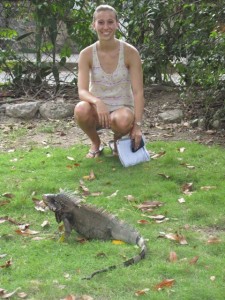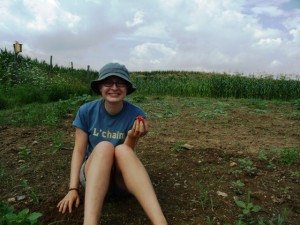
Brooke Kohler ’13 with an iguana on St. John
There are worse places to spend the summer break than on a Caribbean island.
Brooke Kohler ’13 and Jephord English ’12 spent part of their summer on St. John in the U.S. Virgin Islands, but they weren’t there to lounge on the beaches.
Kohler and English are part of Lafayette’s interdisciplinary Summer Mellon Scholars program, which provides stipends for selected students to participate in research related to environmental issues. Over the past couple months, the program hosted 10 student/faculty projects in the local community and as far away as New Orleans and the Caribbean.
Kohler and English worked on separate but related projects as part of a research team co-directed by Crystal Fortwangler, Mellon Postdoctoral Fellow in environmental studies.
Kohler (Flemington, N.J.), an anthropology and sociology major, is helping to study the abundance and spatial distribution of the green iguana in the U.S. Virgin Islands, where it has recently reappeared in great numbers. She is learning how residents view and interact with the iguana population.
“I love this project because of how multi-dimensional it is. At first when I was told what I would be doing, I thought I was just going to study iguanas. After researching information about them, the relationships they have with people on the island, and the history of indigenous and non-indigenous species, I have learned that there are so many different aspects to these creatures being here on St. John,” Kohler says.
After Lafayette, Kohler plans to enroll in a graduate program in anthropology. “I feel like I am getting real anthropological field experience on this trip, which not every student gets to do,” she says.

Jephord English ’12 plays around with the locals on St. John.
English (Brooklyn, N.Y.), a policy studies major, has focused his attention on cattle. He spent several weeks researching cattle and their effect on the landscape and ecology of the U.S. Virgin Islands. His work also included administering surveys and interviewing historians and island natives.
The information he gathered will be used to produce a report to be submitted to the Virgin Islands National Park outlining a recommended new interpretive program for the public on Afro-Caribbean historical engagement with cattle and livestock on St. John between about 1850 and 1960. The program will include signs, brochures, maps, and self-guided tours that will show visitors how to “read” the historical and natural landscapes in the park that have been shaped by a history of cattle production.
“I’m interested in the fact that over time, a specific factor such as cattle can change the topography and the appearance of landscape,” English says. “Studying policy studies as my major, it makes me wonder how this can be avoided. What stipulations or guidelines can be put in place for the natural habitat to remain accessible for all?”

Danielle Sobol ’12 takes water samples from Raritan Bay in New Jersey.
Much farther north, biology majors Danielle Sobol ’12 (Wall Township, N.J.) and Carolyn Cabrey ’12 (North Wales, Pa.) worked with Megan Rothenberger, assistant professor of biology, to conduct chemical and biological analyses of water samples taken from Raritan Bay in New Jersey. Their work will contribute data toward a long-term Raritan Bay monitoring project and will allow them to quantitatively assess how water quality in the estuary has changed over time.
“I think this project is really interesting because it involves many aspects of science. We get to participate in field work which is on a boat and usually very enjoyable, but we also get to do statistical analysis as well as data analysis in the lab. It is a perfect mix of different lab techniques which keeps things interesting,” Cabrey says.
Sobol plans to attend medical school after Lafayette and sees a connection between the Raritan Bay project and her interest in medicine.
“Working on this research shows a concern for the impact on human health, since one thing the team is looking for is the presence of potentially harmful algal blooms. If conditions in the bay contribute to the presence or growth of toxic algal species, this can lead to a buildup of toxins in fish and shellfish meant for human consumption. If there are any [harmful algal blooms] in the bay, an early indication could prevent human illness,” Sobol says.

Julia Seidenstein ’14 in the Lafayette Organic Garden
On campus, geology major Julia Seidenstein ’14 (Lawrenceville, N.J.) has been testing out some organic methods of pest control at the Lafayette Organic Garden, trying to find a way to deal with pesky squash bugs, squash vine borers, and cucumber beetles that gave Lafayette gardeners trouble last year. She has been working with John Wilson, geology laboratory coordinator, and Jennifer Bell, manager of the Lafayette Organic Garden.
She started out by planting seeds and waiting for the bugs to attack the plants.
“Probably not the normal sentiment of a gardener, but it is for the sake of science and a better garden,” she says.
So far, she has found that handpicking the bugs, using row covers until the plants start to flower, spraying with a soap and water mix, and spraying with organic chemicals like neem oil are all successful organic pest control techniques.
“These are all things I could do right away, but there are also methods that are a longer process. Building soil health, for example, will help with a plant’s ability to resist or tolerate pests. This is something we are working on in the student garden. There are just a few people tending one acre, so having healthier soil would help the crops and save time for us. Organic is less about a quick fix and more about long term and sustainable solutions,” Seidenstein says.
Engineering studies major Thomas Golaszewski ’12 (Hatboro, Pa.) is continuing the work of several Lafayette students who have been modeling the carbon footprint of New Orleans’s Lower Ninth Ward and estimating the costs associated with mitigating the carbon emissions associated with repopulation and redevelopment in the hurricane- and flood-devastated neighborhood. The project, which is also part of the College’s Economic Empowerment and Global Learning Project, began in 2009 and is expected to be completed in January. He has been working with David Veshosky, associate professor of civil and environmental engineering.
Golaszewski’s focus is developing a geographic information systems database to analyze alternative land use and economic development policies in the area.
“I am interested in this project because of the way it has a direct impact on a community in need. The models and numbers that we develop will help the local community in their efforts toward carbon neutrality and provide them with a realistic way of reaching these goals,” Golaszewski says.
He says the research has been difficult at times and has required a lot of patience.
“I have learned better research methods and how to overcome conflicting data or a lack of information on a subject. Being in New Orleans has also helped me to experience working with different groups and organizations. Successful networking is the key to a successful career and being able to meet and collaborate with the groups that work together to restore the Lower Ninth Ward has been a valuable experience,” he says.




1 Comment
Comments are closed.